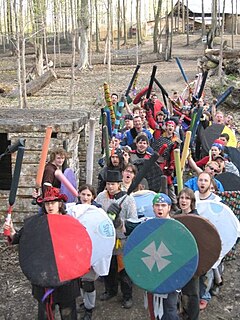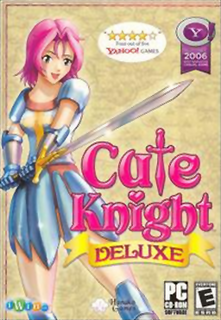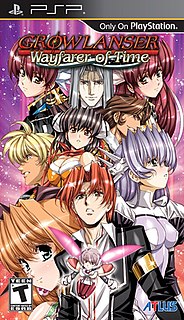Rolemaster is a role-playing game published by Iron Crown Enterprises. Rolemaster has come in four separate editions. The third edition, first published in 1995, is also known as the Rolemaster Standard System. Rolemaster Fantasy Roleplaying was first published in 1999 as a reorganized edition of RMSS, and is largely compatible with that edition. The most recent publication of the Rolemaster rule set is Rolemaster Classic (RMC), a republished set of the second edition rules.
An experience point is a unit of measurement used in tabletop role-playing games (RPGs) and role-playing video games to quantify a player character's progression through the game. Experience points are generally awarded for the completion of missions, overcoming obstacles and opponents, and for successful role-playing.

Amtgard is a battle gaming and live-action fantasy roleplaying and boffer combat game with chapters primarily based in the United States and Canada as well as Germany, Croatia, and South Korea.

Nox is an action role-playing game developed by Westwood Pacific and published by Electronic Arts in 2000 for Microsoft Windows. It details the story of Jack, a young man from Earth who is pulled into a high fantasy parallel universe and has to defeat the evil sorceress Hecubah and her army of Necromancers to return home. Depending on the player's choice of character class at the beginning of the game, the game follows three largely different linear storylines, each leading to its unique ending. In the multiplayer, players can compete against each other in various game modes such as deathmatch and capture the flag, while the freely downloadable expansion pack NoxQuest added a cooperative multiplayer mode. The game was generally well received by critics and the media.

The magic of Dungeons & Dragons consists of the spells and magic systems used in the settings of the role-playing game Dungeons & Dragons (D&D). D&D defined the genre of fantasy role-playing games, and remains the most popular table-top version. Many of the original concepts have become widely used in the role-playing community across many different fictional worlds, as well as across all manner of popular media including books, board games, video games, and movies.

Magic or mana is an attribute assigned to characters within a role-playing or video game that indicates their power to use special abilities or "spells". Magic is usually measured in magic points or mana points, shortened as MP. Different abilities will use up different amounts of MP. When the MP of a character reaches zero, the character won't be able to use special abilities until some of their MP is recovered.
In role-playing games, a status effect is a temporary modification to a game character’s original set of stats that usually comes into play when special powers and abilities are used, often during combat. It appears in numerous computer and video games of many genres, most commonly in role-playing video games. The term status effect can be applied both to changes that provide a character an advantage, and those that hinder the character . Especially in MMORPGs, beneficial effects are referred to as buffs, and hindering effects are called debuffs.
Dark Ages is a MMORPG based on Celtic mythology, originally developed by Nexon and now operated by KRU Interactive. It is loosely based on the Korean game Legend of Darkness. The American version was developed by David Ethan Kennerly who based it somewhat on the works of horror writer H. P. Lovecraft. The game originally thrived on player involvement in the management of the game and progression of the storyline, even going so far as allowing players control over in-game politics and laws.

Tactics Ogre: The Knight of Lodis is a tactical role-playing game developed by Quest. It was released by Nintendo in Japan in 2001 on the Game Boy Advance, then later released by Atlus in North America in 2002.

Legend of Legaia is a PlayStation action role-playing game developed by Prokion and Contrail. It was followed by Legaia 2: Duel Saga.
In video gaming, the HUD or status bar is the method by which information is visually relayed to the player as part of a game's user interface. It takes its name from the head-up displays used in modern aircraft.

Tri-Stat dX is a generic role-playing game system developed and published by Guardians of Order in 2003. Like other generic role-playing game systems, Tri-Stat dX has adaptable rules that can be applied to many genres and settings.

Dungeons & Dragons: Shadow over Mystara is an arcade game developed and published by Capcom in 1996 as a sequel to Dungeons & Dragons: Tower of Doom. The game is set in the Dungeons & Dragons campaign setting of Mystara.

Character creation is the process of defining a game character or other character. Typically, a character's individual strengths and weaknesses are represented by a set of statistics. Games with a largely fictional setting may include traits such as race and class. Games with a more contemporary or narrower setting may limit customization to physical and personality traits.

Cute Knight is a casual life simulation role-playing video game with many possible endings and careers featuring a single female character. Gameplay is similar to the Japanese Princess Maker with a more traditionally Western first-person perspective dungeons.

Legend, also known as The Four Crystals of Trazere in the United States, is an isometric fantasy role-playing game released in 1992 for the Amiga, Atari ST, and DOS. It was developed by Pete James and Anthony Taglione for the then UK-based Mindscape, and published by The Software Toolworks. In the game, the player controls four adventurers on a quest to save the land of Trazere from an ancient, re-awakening evil. In 1993, Mindscape released a sequel, Worlds of Legend: Son of the Empire.
Dofus Arena was a free turn-based strategic online game and was the second game of Ankama Games. It was a PvP game based on the story of Dofus. Dofus Arena incarnates the essence of DOFUS's gameplay, featuring increasingly difficult tactical fights. As a coach, each player creates and manages his own unique team of characters, enabling him to face opponents of all kinds, in different elements.

Growlanser: Wayfarer of Time is a tactical role-playing game developed by Career Soft and published by Atlus. It was originally released for the PlayStation 2 in Japan in December 2003, and later for the PlayStation Portable in Japan in August 2011 and in North America in July 2012. It is the fourth installment in the Growlanser series, with character designs by Satoshi Urushihara.

Final Fantasy Record Keeper is a free-to-play role-playing game developed and published by DeNA for iOS and Android. The game features characters, scenarios and battles from the mainline Final Fantasy series. It was released in Japan on September 24, 2014, and worldwide on March 26, 2015.

Twenty-five full expansions for the MMORPG EverQuest have been released. Expansions are purchased separately from the original game and each other and provide additional content to the game. Additionally, the game is updated through downloaded patches.















